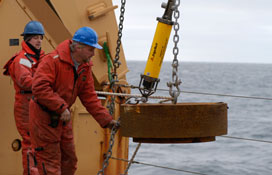 |
 |
 |
| Ryan Schrawder (left)
and John Kemp (right) guide the mooring anchor over the side
during the anchor-first deployment of BS3 today. |
| Click
to enlarge |
Daily Update
Calendar
Dispatch 26 - October 5, 2003
By C. A. Linder
Weather conditions: Mostly cloudy skies, 25 kt winds, 4-6
ft seas, air temperature 28°F
Mission Accomplished
One, Three, Two, done! The WHOI mooring team made a clean sweep
today by finishing the mooring array deployment. We started with
the shallowest mooring, BS1. This mooring is different from the
others. Since the water is so shallow at this site, the mooring
was designed as a tripod frame holding
a CTD and ADCP.
The frame was built at WHOI using a water jet cutter. This amazing
machine cuts aluminum, titanium, anything - using a concentrated
jet of water and powdered garnet. It was an easy deployment - we
simply lowered it down most of the way to the bottom and released
it.
After lunch we cruised past the second mooring spot to the third
(BS3), so we could take care of a more complicated mooring. BS3
is special this year because we have included an extra instrument
called the arctic winch. This
device is like an upside down yo-yo. It is attached to the top mooring
float by a line. Twice a day, the yo-yo lets out its CTD (attached
to a buoy to make it float). It floats to the surface (or the bottom
of the ice), and then it gets reeled back in to the top float. This
allows us to measure the water properties from the top of the top
float to the underside of the ice. Since we didn't want to damage
the arctic winch, John Kemp deployed the mooring anchor-first (usually
in open water, moorings are deployed anchor last so that there is
less tension on the line). In 26 years of mooring work John has
never done an anchor-first deployment in open water, so today was
a day of firsts!
The last mooring of the day (BS2) was deployed after dinner, in
traditional anchor-last fashion. This was the second shallowest
mooring, and as such was very short. In no time at all, the team
had the mooring in the water. As night began to fall, John pulled
the release and everyone shook hands on the fantail - the mooring
marathon was over!
This question comes from Mrs. Werner's 6th
grade class at the Morse Pond School. They have been studying
the different basins of the Arctic Ocean and the sea life that lives
in each realm.
Question from Karen: When I read about the Canadian Basin, I was instantly fascinated. It reminded me of how Australia was isolated during the formation of the continents and therefore the animals were unique. Can you tell me anything about the basin or is there really nothing known? Have any frozen bodies of animals been found?
Answer: I asked Carin Ashjian to answer this question.
She is involved in a number of different projects studying the marine
life on the arctic shelves and the Canadian Basin.
"We know something about the water column of the Canadian Basin
because we've been studying the plankton and chemistry there from
ice camps and some limited expeditions. There is communication between
the Canadian Basin and other parts of the Arctic in the water column.
For example, the mid-depths (200-700 meters or about 1/2 a mile) of
the Canadian Basin are filled with water originally from the Atlantic
Ocean. And the upper 200 meters also is mixed with water from other
regions. However, we don't know that much about the animals in the
deep-sea of the Canadian Basin and who knows what we might find!"
Tim from Mrs. Cadwell's
class at Varnum Brook Elementary School has this question:
Question: How long until you can call your mission
a success?
Answer: Hi, Tim. We can call the mission a success
as of today! The primary goals of this year's cruise were to extract
the moorings that we deployed last year, retrieve the data, and
put the moorings back in the water. We just put the last mooring
in the water this evening. Now we will be peforming one last CTD
section along the mooring line, and perhaps sampling some deeper
water on the edge of the Canadian Basin.
This question is from Peter from Holly Springs, North Carolina.
Question: Have you seen any other ships? If so, from
what country?
Answer: Although I haven't seen any, last night
the bridge watchstanders saw the lights of the Canadian icebreaker
Laurier in the distance. They are also on a scientific
mission only 40 miles from us. The Canadian icebreaker Louis
S. St-Laurent also just completed an expedition to the Beaufort
Sea (read dispatches and see photos from this expedition here),
and Russian icebreakers frequently undertake scientific and tourist
expeditions as far north as the Pole. The other US Coast Guard icebreakers,
Polar Star and Polar Sea, are currently in their
home port of Seattle getting ready for a trip to Antarctica.
Tonight the mooring crew (and Bob Pickart) will be sleeping soundly, knowing that
the WHOI mooring array is working away beneath the waves, collecting data for another
year.
 Previous
Dispatch
Next Dispatch Previous
Dispatch
Next Dispatch

Back to
Calendar
|




